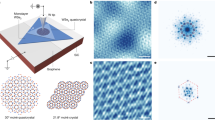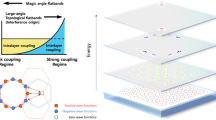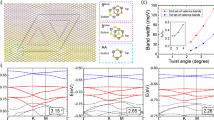Abstract
Forming long-wavelength moiré superlattices in van der Waals bilayers that have a small-angle twist between the two layers has been a key approach for creating moiré flat bands. However, for small twist angles, strong lattice reconstruction creates domain walls and other forms of disorder in the moiré pattern, posing considerable challenges for engineering such platforms. At large twist angles, the lattices are more rigid, but it is difficult to produce flat bands in shorter-wavelength moiré superlattices. Here we introduce an approach for tailoring robust supermoiré structures in bilayers of transition-metal dichalcogenides using only a single twist near a commensurate angle. Structurally, we show the spontaneous formation of a periodic arrangement of three inequivalent commensurate moiré stackings, where the angle deviation from the commensurate angle determines the periodicity. Electronically, we reveal a large set of van Hove singularities that indicate strong band hybridization, leading to flat bands near the valence band maximum. Our study extends the study of the interplay among band topology, quantum geometry and moiré superconductivity to the large twist angle regime.
This is a preview of subscription content, access via your institution
Access options
Access Nature and 54 other Nature Portfolio journals
Get Nature+, our best-value online-access subscription
$32.99 / 30 days
cancel any time
Subscribe to this journal
Receive 12 print issues and online access
$259.00 per year
only $21.58 per issue
Buy this article
- Purchase on SpringerLink
- Instant access to full article PDF
Prices may be subject to local taxes which are calculated during checkout





Similar content being viewed by others
Data availability
Source data for the plots in Supplementary Information are available upon request. Other data are available via figshare at https://doi.org/10.6084/m9.figshare.28558070 (ref. 59). Source data are provided with this paper.
Code availability
The codes described in Supplementary Information are available upon reasonable request.
References
Bistritzer, R. & MacDonald, A. H. Moiré bands in twisted double-layer graphene. Proc. Natl Acad. Sci. USA 108, 12233–12237 (2011).
Cao, Y. et al. Unconventional superconductivity in magic-angle graphene superlattices. Nature 556, 43–50 (2018).
Park, H. et al. Observation of fractionally quantized anomalous Hall effect. Nature 622, 74–79 (2023).
Zeng, Y. et al. Thermodynamic evidence of fractional Chern insulator in moiré MoTe2. Nature 622, 69–73 (2023).
Tsui, Y.-C. et al. Direct observation of a magnetic-field-induced Wigner crystal. Nature 628, 287–292 (2024).
Craig, I. M. et al. Local atomic stacking and symmetry in twisted graphene trilayers. Nat. Mater. 23, 323–330 (2024).
Devakul, T. et al. Magic-angle helical trilayer graphene. Sci. Adv. 9, eadi6063 (2023).
Uri, A. et al. Superconductivity and strong interactions in a tunable moiré quasicrystal. Nature 620, 762–767 (2023).
Hao, Z. et al. Electric field–tunable superconductivity in alternating-twist magic-angle trilayer graphene. Science 371, 1133–1138 (2021).
Kim, H. et al. Evidence for unconventional superconductivity in twisted trilayer graphene. Nature 606, 494–500 (2022).
Turkel, S. et al. Orderly disorder in magic-angle twisted trilayer graphene. Science 376, 193–199 (2022).
Grover, S. et al. Chern mosaic and Berry-curvature magnetism in magic-angle graphene. Nat. Phys. 18, 885–892 (2022).
Weston, A. et al. Atomic reconstruction in twisted bilayers of transition metal dichalcogenides. Nat. Nanotechnol. 15, 592–597 (2020).
Gadelha, A. C. et al. Localization of lattice dynamics in low-angle twisted bilayer graphene. Nature 590, 405–409 (2021).
Li, E. et al. Lattice reconstruction induced multiple ultra-flat bands in twisted bilayer WSe2. Nat. Commun. 12, 5601 (2021).
Li, Y. et al. Tuning commensurability in twisted van der Waals bilayers. Nature 625, 494–499 (2024).
Koren, E. et al. Coherent commensurate electronic states at the interface between misoriented graphene layers. Nat. Nanotechnol. 11, 752–757 (2016).
Bistritzer, R. & MacDonald, A. H. Transport between twisted graphene layers. Phys. Rev. B 81, 245412 (2010).
Mele, E. J. Commensuration and interlayer coherence in twisted bilayer graphene. Phys. Rev. B 81, 161405 (2010).
Zhao, X. et al. Unveiling atomic-scale moiré features and atomic reconstructions in high-angle commensurately twisted transition metal dichalcogenide homobilayers. Nano Lett. 21, 3262–3270 (2021).
Jiang, Y. et al. Electron ptychography of 2D materials to deep sub-ångström resolution. Nature 559, 343–349 (2018).
Nguyen, K. X. et al. Achieving sub-0.5-angstrom–resolution ptychography in an uncorrected electron microscope. Science 383, 865–870 (2024).
Liu, Y. et al. Pair density wave state in a monolayer high-Tc iron-based superconductor. Nature 618, 934–939 (2023).
Chen, Z. et al. Mixed-state electron ptychography enables sub-angstrom resolution imaging with picometer precision at low dose. Nat. Commun. 11, 2994 (2020).
Sung, S. H. et al. Torsional periodic lattice distortions and diffraction of twisted 2D materials. Nat. Commun. 13, 7826 (2022).
Kim, J. et al. Anomalous optical excitations from arrays of whirlpooled lattice distortions in moiré superlattices. Nat. Mater. 21, 890–895 (2022).
Ugeda, M. M. et al. Giant bandgap renormalization and excitonic effects in a monolayer transition metal dichalcogenide semiconductor. Nat. Mater. 13, 1091–1095 (2014).
Chen, P. et al. Tunable moiré superlattice of artificially twisted monolayers. Adv. Mater. 31, 1901077 (2019).
Zhang, C. et al. Probing critical point energies of transition metal dichalcogenides: surprising indirect gap of single layer WSe2. Nano Lett. 15, 6494–6500 (2015).
Galperin, M., Ratner, M. A. & Nitzan, A. Inelastic electron tunneling spectroscopy in molecular junctions: peaks and dips. J. Chem. Phys. 121, 11965–11979 (2004).
Klein, J., Léger, A., Belin, M., Défourneau, D. & Sangster, M. J. L. Inelastic-electron-tunneling spectroscopy of metal-insulator-metal junctions. Phys. Rev. B 7, 2336–2348 (1973).
Stipe, B. C., Rezaei, M. A. & Ho, W. Single-molecule vibrational spectroscopy and microscopy. Science 280, 1732–1735 (1998).
Wu, F., Lovorn, T., Tutuc, E., Martin, I. & MacDonald, A. H. Topological insulators in twisted transition metal dichalcogenide homobilayers. Phys. Rev. Lett. 122, 086402 (2019).
Morales-Durán, N., Wei, N., Shi, J. & MacDonald, A. H. Magic angles and fractional Chern insulators in twisted homobilayer transition metal dichalcogenides. Phys. Rev. Lett. 132, 096602 (2024).
Gao, Q., Dong, J., Ledwith, P., Parker, D. & Khalaf, E. Untwisting moiré physics: almost ideal bands and fractional Chern insulators in periodically strained monolayer graphene. Phys. Rev. Lett. 131, 096401 (2023).
Balents, L., Dean, C. R., Efetov, D. K. & Young, A. F. Superconductivity and strong correlations in moiré flat bands. Nat. Phys. 16, 725–733 (2020).
Yankowitz, M., McKenzie, D. & LeRoy, B. J. Local spectroscopic characterization of spin and layer polarization in WSe2. Phys. Rev. Lett. 115, 136803 (2015).
Hoffman, J. E. et al. Imaging quasiparticle interference in Bi2Sr2CaCu2O8+δ. Science 297, 1148–1151 (2002).
Foutty, B. A. et al. Mapping twist-tuned multiband topology in bilayer WSe2. Science 384, 343–347 (2024).
Zhang, F. et al. Experimental signature of layer skyrmions and implications for band topology in twisted WSe2 bilayers. Preprint at https://arxiv.org/abs/2406.20036 (2025).
Redekop, E. et al. Direct magnetic imaging of fractional Chern insulators in twisted MoTe2. Nature 635, 584–589 (2024).
Xia, Y. et al. Superconductivity in twisted bilayer WSe2. Nature https://doi.org/10.1038/s41586-024-08116-2 (2024).
Guo, Y. et al. Superconductivity in 5.0° twisted bilayer WSe2. Nature 637, 839–845 (2025).
Lin, Y.-C. et al. Realizing large-scale, electronic-grade two-dimensional semiconductors. ACS Nano 12, 965–975 (2018).
Wang, L. et al. One-dimensional electrical contact to a two-dimensional material. Science 342, 614–617 (2013).
Liu, S. et al. Two-step flux synthesis of ultrapure transition-metal dichalcogenides. ACS Nano 17, 16587–16596 (2023).
Tate, M. W. et al. High dynamic range pixel array detector for scanning transmission electron microscopy. Microsc. Microanal. 22, 237–249 (2016).
Yin, X., Shi, C., Han, Y. & Jiang, Y. PEAR: a robust and flexible automation framework for ptychography enabled by multiple large language model agents. Preprint at https://arxiv.org/abs/2410.09034 (2024).
Han, Y. et al. Strain mapping of two-dimensional heterostructures with subpicometer precision. Nano Lett. 18, 3746–3751 (2018).
Giannozzi, P. et al. QUANTUM ESPRESSO: a modular and open-source software project for quantum simulations of materials. J. Phys. Condens. Matter 21, 395502 (2009).
Giannozzi, P. et al. Advanced capabilities for materials modelling with Quantum ESPRESSO. J. Phys. Condens. Matter 29, 465901 (2017).
Perdew, J. P., Burke, K. & Ernzerhof, M. Generalized gradient approximation made simple. Phys. Rev. Lett. 77, 3865–3868 (1996).
Hamann, D. R. Optimized norm-conserving Vanderbilt pseudopotentials. Phys. Rev. B 88, 085117 (2013).
Van Setten, M. J. et al. The PseudoDojo: training and grading a 85 element optimized norm-conserving pseudopotential table. Comput. Phys. Commun. 226, 39–54 (2018).
Grimme, S., Antony, J., Ehrlich, S. & Krieg, H. A consistent and accurate ab initio parametrization of density functional dispersion correction (DFT-D) for the 94 elements H–Pu. J. Chem. Phys. 132, 154104 (2010).
Medeiros, P. V. C., Stafström, S. & Björk, J. Effects of extrinsic and intrinsic perturbations on the electronic structure of graphene: retaining an effective primitive cell band structure by band unfolding. Phys. Rev. B 89, 041407 (2014).
Medeiros, P. V. C., Tsirkin, S. S., Stafström, S. & Björk, J. Unfolding spinor wave functions and expectation values of general operators: introducing the unfolding-density operator. Phys. Rev. B 91, 041116 (2015).
Iraola, M. et al. IrRep: symmetry eigenvalues and irreducible representations of ab initio band structures. Comput. Phys. Commun. 272, 108226 (2022).
Li, Y. et al. Data for ‘Robust super-moiré pattern in large-angle single-twist bilayers’. figshare https://doi.org/10.6084/m9.figshare.28558070 (2025).
Acknowledgements
We acknowledge Y.-W. Son for a useful discussion. Y.L., F.Z., H.K. and C.-K.S. are mainly supported by the NSF through the Center for Dynamics and Control of Materials: an NSF Materials Research Science and Engineering Center (Cooperative Agreement No. DMR-2308817) and partially by the US Air Force (Grant No. FA2386-21-1-4061), NSF (Grant Nos. DMR-1808751 and DMR-2219610) and the Welch Foundation (Grant No. F-2164). C.S. and Y.H. acknowledge support from the NSF (Grant No. CMMI-2239545) and the Welch Foundation (Grant No. C-2065). V.-A.H. and F.G. were supported by the Welch Foundation (Grant No. F-2139-20230405). V.-A.H. and F.G. acknowledge the National Energy Research Scientific Computing Center (a DOE Office of Science User Facility supported under Contract No. DE-AC02-05CH11231) and the Texas Advanced Computing Center at the University of Texas at Austin for providing computational resources. X. Liu and X. Li were partially supported by the Department of Energy, Office of Basic Energy Sciences (Grant No. DE-SC0019398 for device fabrication) and the Welch Foundation chair (Grant No. F-0014 for sample preparation). C.D. and J.A.R. were supported by the Penn State Center for Nanoscale Science (NSF Grant No. DMR-2011839) and the Penn State 2DCC-MIP (NSF Grant No. DMR-1539916). Y.-C.L. acknowledges the support from the Center for Emergent Functional Matter Science of NYCU and the Yushan Young Scholar Program from the Ministry of Education of Taiwan. L.N.H., M.H., J.H. and K.B are supported by the NSF MRSEC programme at Columbia through the Center for Precision-Assembled Quantum Materials (NSF Grant No. DMR-2011738). Y.X., Q.G. and E.K. are supported by the NSF through the Center for Dynamics and Control of Materials: an NSF Materials Research Science and Engineering Center (Cooperative Agreement No. DMR-2308817).
Author information
Authors and Affiliations
Contributions
C.-K.S. and Y.L. conceived the experiment. Y.L. and F.Z. carried out the STM and STS measurements. C.S. and Y.H. carried out the STEM measurements. C.S. and Y.J. performed the electron ptychography reconstruction. Y.X., Q.G. and E.K. performed the theoretical model calculations. N.M.-D. was involved in the discussion of the continuum model of TMDs. V.-A.H. and F.G. performed the density functional theory calculations. Y.-C.L. synthesized the twisted WSe2 bilayers. C.D. prepared the graphitic buffer layer/SiC. J.A.R. supervised the sample preparation effort. H.K. annealed and pretreated the samples. X. Liu and Y.L. prepared the exfoliated samples for STEM and STM under the supervision of X. Li. L.N.H., M.H., K.B. and J.H. synthesized the WSe2 bulk crystals. Y.L., F.Z., Y.H., C.S. and C.-K.S. analysed the STM and STEM data. Y.L., C.S., Y.H., E.K. and C.-K.S. wrote the paper with contributions from all authors.
Corresponding authors
Ethics declarations
Competing interests
The authors declare no competing interests.
Peer review
Peer review information
Nature Physics thanks Jiamin Xue and the other, anonymous, reviewer(s) for their contribution to the peer review of this work.
Additional information
Publisher’s note Springer Nature remains neutral with regard to jurisdictional claims in published maps and institutional affiliations.
Extended data
Extended Data Fig. 1 STM/S measurement of a fabricated θt ≈ 31.5° twisted bilayer WSe2 SM.
a, An STM image of the 31.5° twisted bilayer WSe2, showing a <1011 cm−2 low density of defects thanks to the high-quality bulk crystal WSe2 (VBias = −0.98 V, I = 100 pA). b, An in-gap taken STM topography image of θt ≈ 31.5° tWSe2 (VBias = −0.6 V, I = 100 pA), revealing unambiguous SM patterns. c, The FFT image of b. The black squares, blue circles, and red diamonds represent top layer WSe2 Bragg peaks, second order and first order tWSe2 moiré, with SM splitting, respectively. d, Filtered iFFT image using the FFT peaks in red diamonds. e, The logarithmic scale constant height STS taken in the pristine region (Vset = −2.0 V, I = 100 pA, Vamp = 29 mV). Blue and green arrows represent the \({\Gamma }_{1}\) and KVBM respectively. f, The constant current STS taken at the same site (Vint = −1.4 V, I = 50 pA, Vamp = 19 mV). Blue and green arrows represent the \({\Gamma }_{1}\) and KVBM respectively. Scale bars: 3 nm.
Extended Data Fig. 2 Quasiparticle interferences measurement and analysis on the fabricated θt ≈ 31.5° twisted bilayer WSe2 SM.
a–c, The constant current dI/dV mappings taken at −1.0 V (a), −0.98 V (b), and −0.96 V (c) (I = 100 pA, Vamp = 20 mV). d, Schematic of the intra-K-valley scattering in θt ≈ 31.5° SM. The purple and grey BZs depict the CM and SM BZs, respectively. ∆SM is the SM minigap while ∆CM is the CM minigap. The blue arrow exhibits the q vector from intra-K-valley scatterings. The SM γ overlaps with CM Γm and Km valleys. e–g, The FFT images of a-c, Red boxes label the regions of quasiparticle interference q vector rings near the center. Insets: magnified near-zero FFT frequency images in the red boxes, showing the rings of quasiparticle interference. h, E v.s. q/2 plot extracted from the quasiparticle interferences of θt ≈ 31.5° tWSe2 sample. The quasiparticle interferences measured under 77K can infer the intra-K-valley scatterings information. The blue curve shows the parabolic fitting of K-valley band dispersion from the three quasiparticle interference measurement dots. The fitted effective mass and KVBM energy levels are meff = 0.55 ± 0.1, EKVBM = −0.925 ± 0.1 eV. The vertical error bars, shown as grey lines, are set as 20 meV in E due to local field fluctuation. The horizontal error bars, also shown as grey lines, are from the q estimations in each Fourier transferred images, which is limited by the image resolution, field of view and quasiparticle interference ring width. Scale bars: a, b, c, 3 nm.
Supplementary information
Supplementary Information
Supplementary Figs. 1–27 and Notes 1–6.
Source data
Source Data Fig. 3
Statistical source data.
Source Data Fig. 4
Statistical source data.
Rights and permissions
Springer Nature or its licensor (e.g. a society or other partner) holds exclusive rights to this article under a publishing agreement with the author(s) or other rightsholder(s); author self-archiving of the accepted manuscript version of this article is solely governed by the terms of such publishing agreement and applicable law.
About this article
Cite this article
Li, Y., Shi, C., Zhang, F. et al. Robust supermoiré pattern in large-angle single-twist bilayers. Nat. Phys. 21, 1085–1092 (2025). https://doi.org/10.1038/s41567-025-02914-9
Received:
Accepted:
Published:
Issue date:
DOI: https://doi.org/10.1038/s41567-025-02914-9



